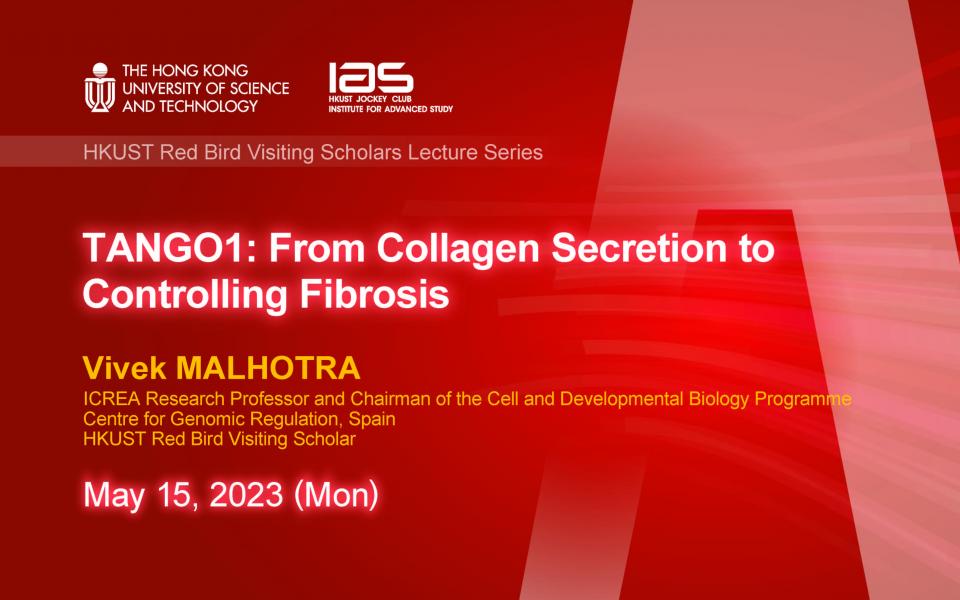HKUST Red Bird Visiting Scholars Lecture Series - TANGO1: From Collagen Secretion to Controlling Fibrosis
Abstract
Secreted collagens compose 25% of our dry protein weight and necessary for tissue organization, and skin and bone formation. But how are these bulky cargoes that are too big to fit into a conventional COPII vesicle exported from the endoplasmic reticulum (ER)? The speaker and his research group’s discovery of TANGO1 (Bard, Nature 2006; Saito, Cell 2009; Saito, Mol Biol Cell 2011; Santos, J Cell Biol 2016; Malhotra, Ann Rev Cell Dev Biol 2019), a ubiquitously expressed, ER-exit-site-resident, transmembrane protein has made the pathway of collagen secretion amenable to molecular analysis. TANGO1 acts as a scaffold to connect collagens in the lumen to COPII coats on the cytoplasmic side of ER. However, the growth of the collagen containing mega transport carrier is not simply by accretion of a larger COPII coated patch of ER membrane, but instead by rapid addition of premade ERGIC 53 containing small vesicles and tubules. This mode of transport carrier formation is fundamentally different from that used to produce small COPII vesicles. The speaker and his research group have seen that TANGO1 rings the ER exit site and thus organizes a sub compartment within the ER (Nogueira, eLife 2014; Santos, eLife 2015; Raote, J Cell Biol 2017). The transmembrane helices of TANGO1 prevent the mixing of ERGIC 53 containing membranes to the bulk of ER (Raote et al., 2020). This allows transport of collagen from the lumen of ER into the ERGIC 53 compartment via a tunnel. They have now mapped all the components that work in concert along with the cargo to assemble TANGO1 into a ring (Raote et al., 2018: Raote and Malhotra 2019; Raote et al., 2020 Raote and Malhotra, 2021; Raote et al., 2022). TANGO1 is genetically mutated in patients with collagenopathies (Lekszas et al., 2020). Their ongoing studies on TANGO1 function in exporting right quantity and quality of collagens and how this activity can be targeted to control collagen hyper secretion dependent tissue fibrosis will be discussed.
About the Speaker
Prof. Vivek Malhotra received his PhD in Biochemistry from Oxford University in 1985. He then pursued his postdoctoral studies at Stanford University. In 1990 - 2007, he was a Professor at the Department of Biology of the University of California, San Diego. He joined the Centre for Genomic Regulation, Barcelona in 2008 and is currently the ICREA Research Professor and the Chairman of the Cell and Developmental Biology Programme there.
Prof. Malhotra is one of world’s leaders on protein secretion and cellular compartmentation. His work is focused on how cellular compartments are made and communicate with each other, and how cells duplicate their compartments during cell division. He has been studying these processes since the late 80s and is acknowledged worldwide for his creativity and novel findings, including the discovery in TANGO1 gene family. He is on the editorial board of Journal of Cell Biology and eLIFE.
Prof. Malhotra is elected a Fellow of the American Association for the Advancement of Science and the American Society for Cell Biology. He is also a Member of the European Molecular Biology Organization. He was awarded the ASBMB–Merck Award in 2013, the SGRF Excellence in Science Award in 2019, and the Humboldt Research Award in 2020.
For Attendees' Attention
Seating is on a first come, first served basis.
